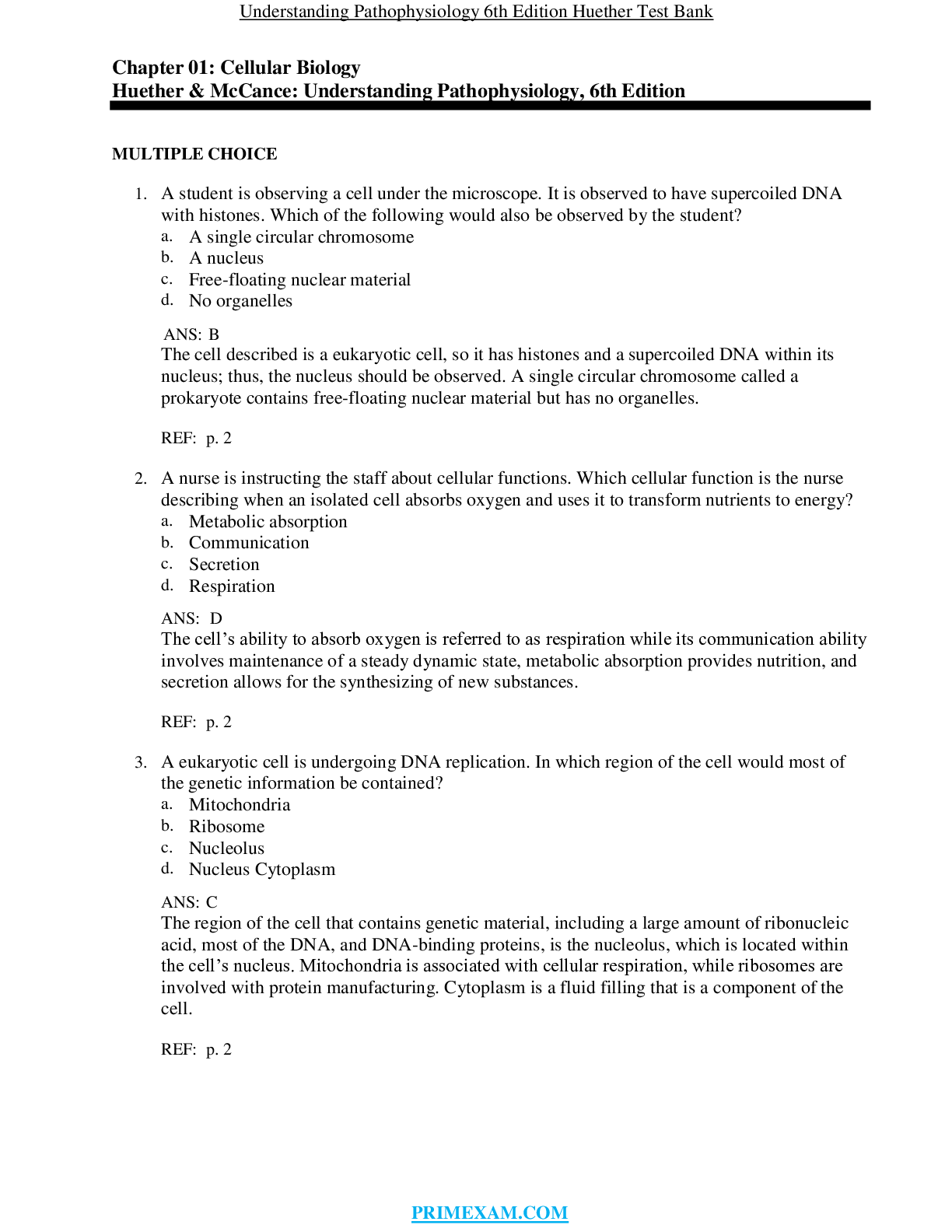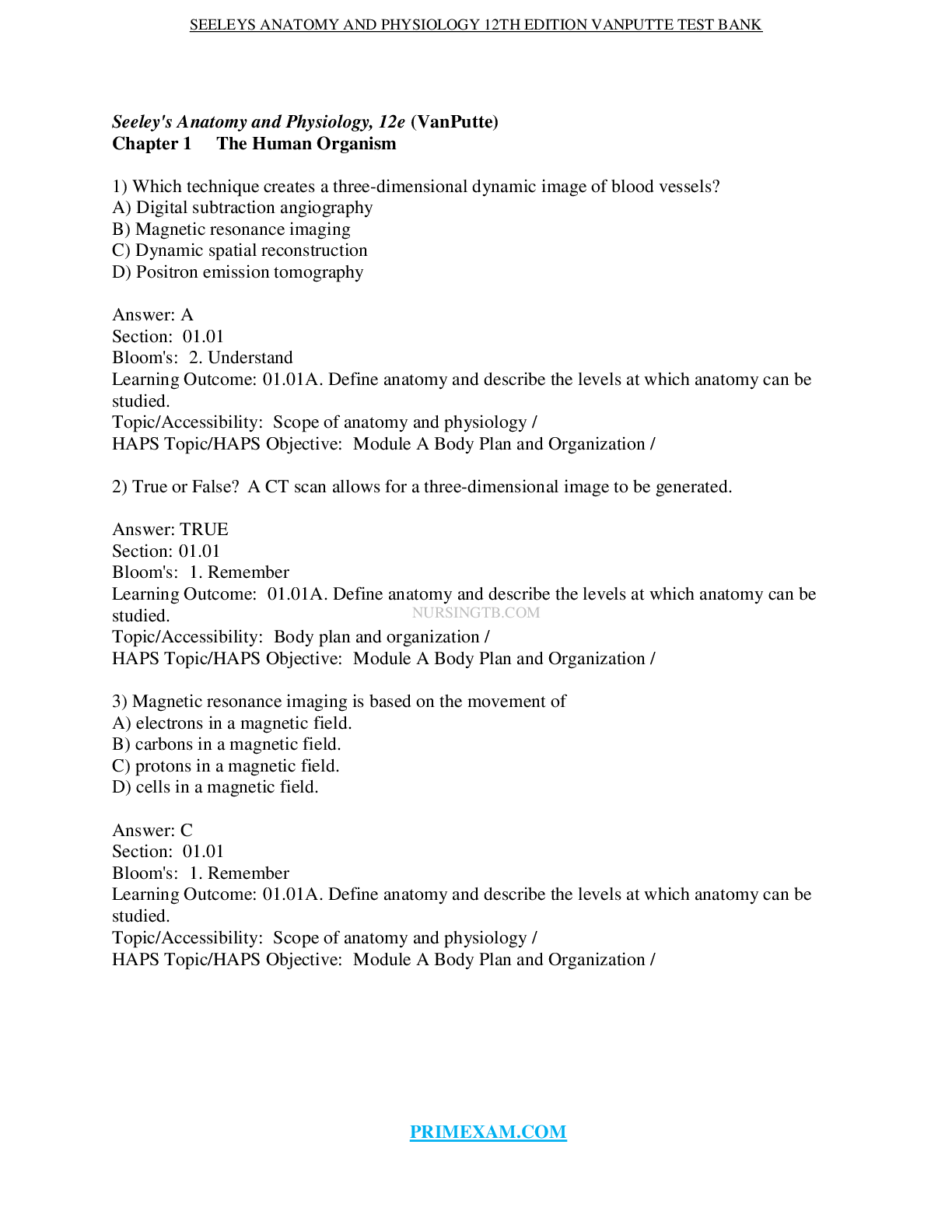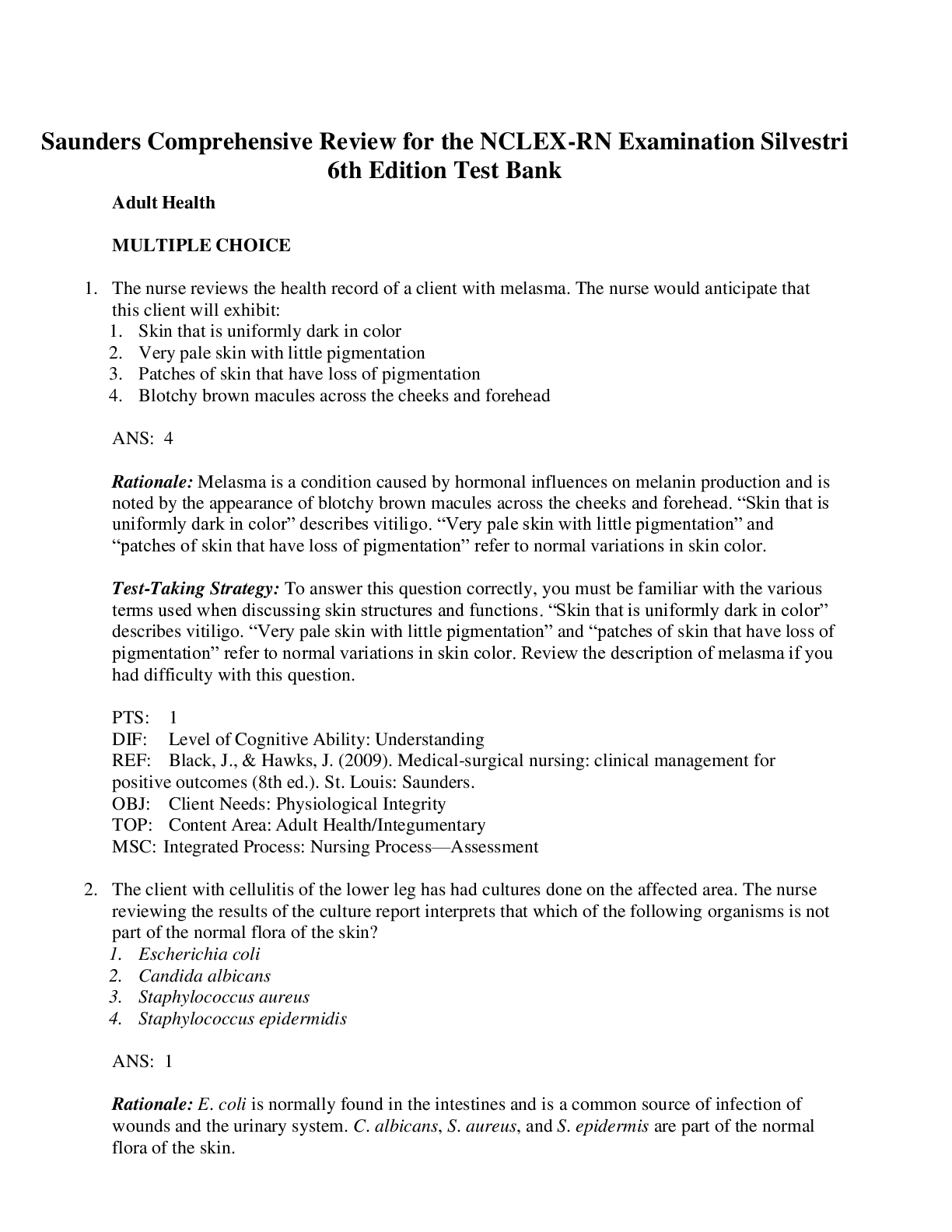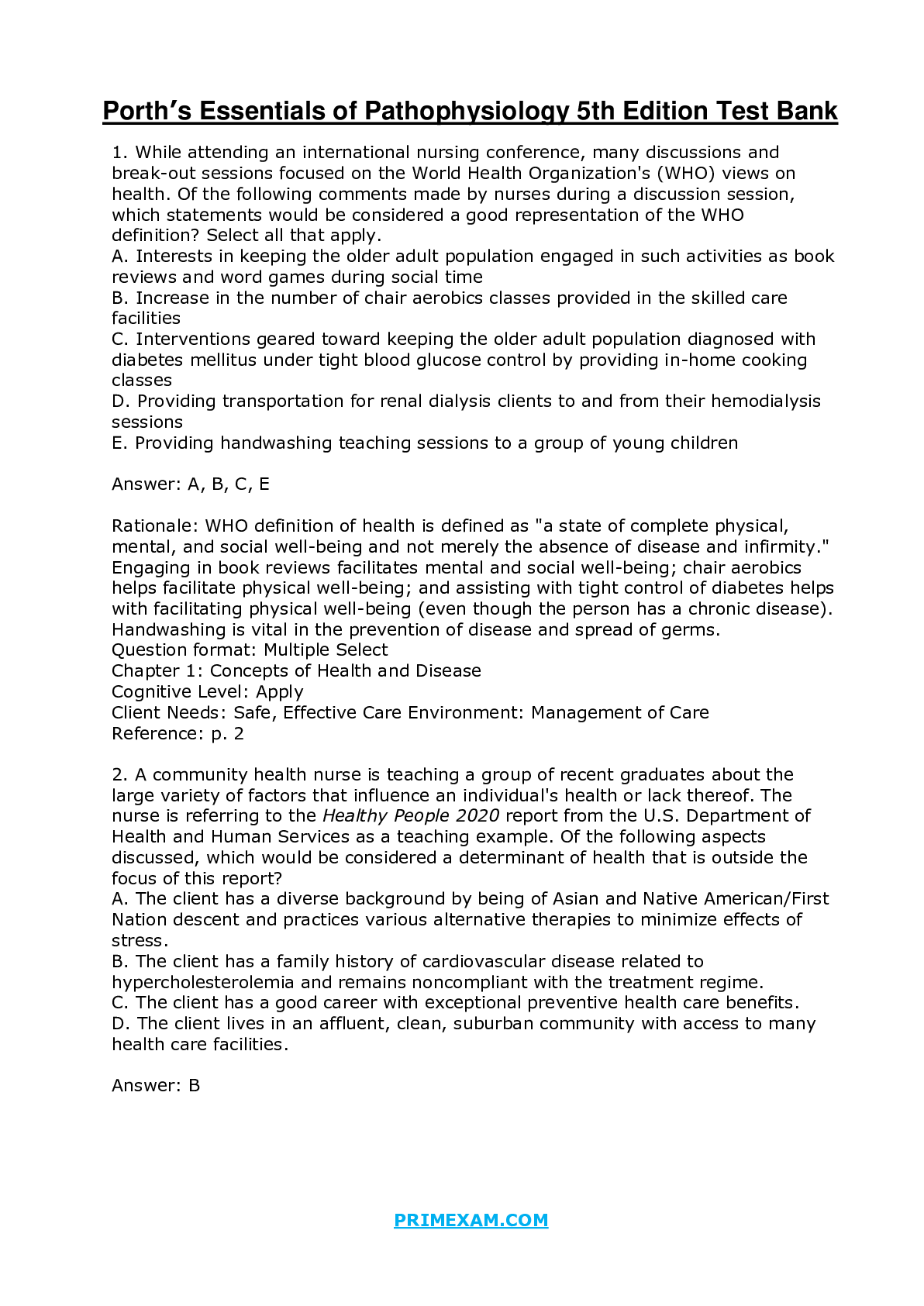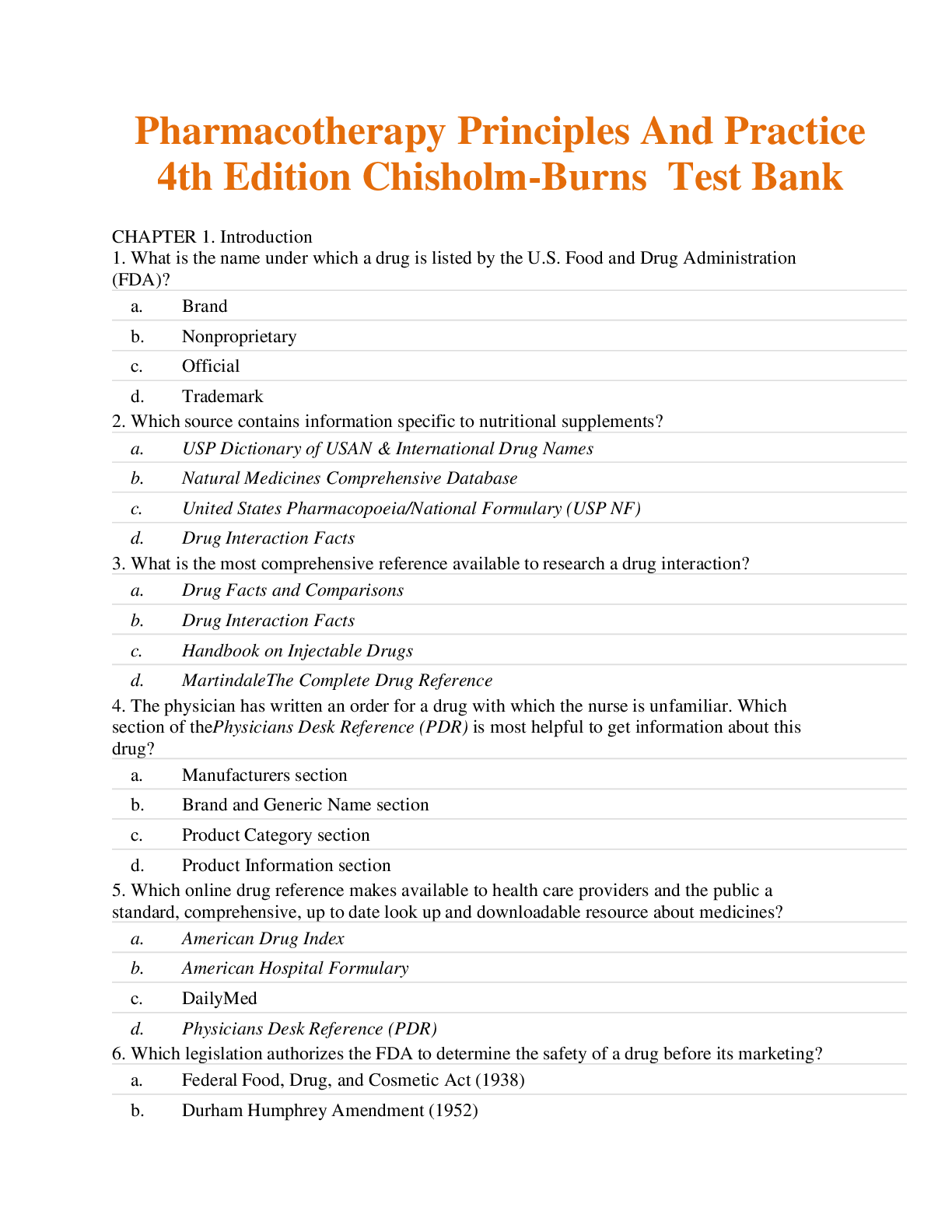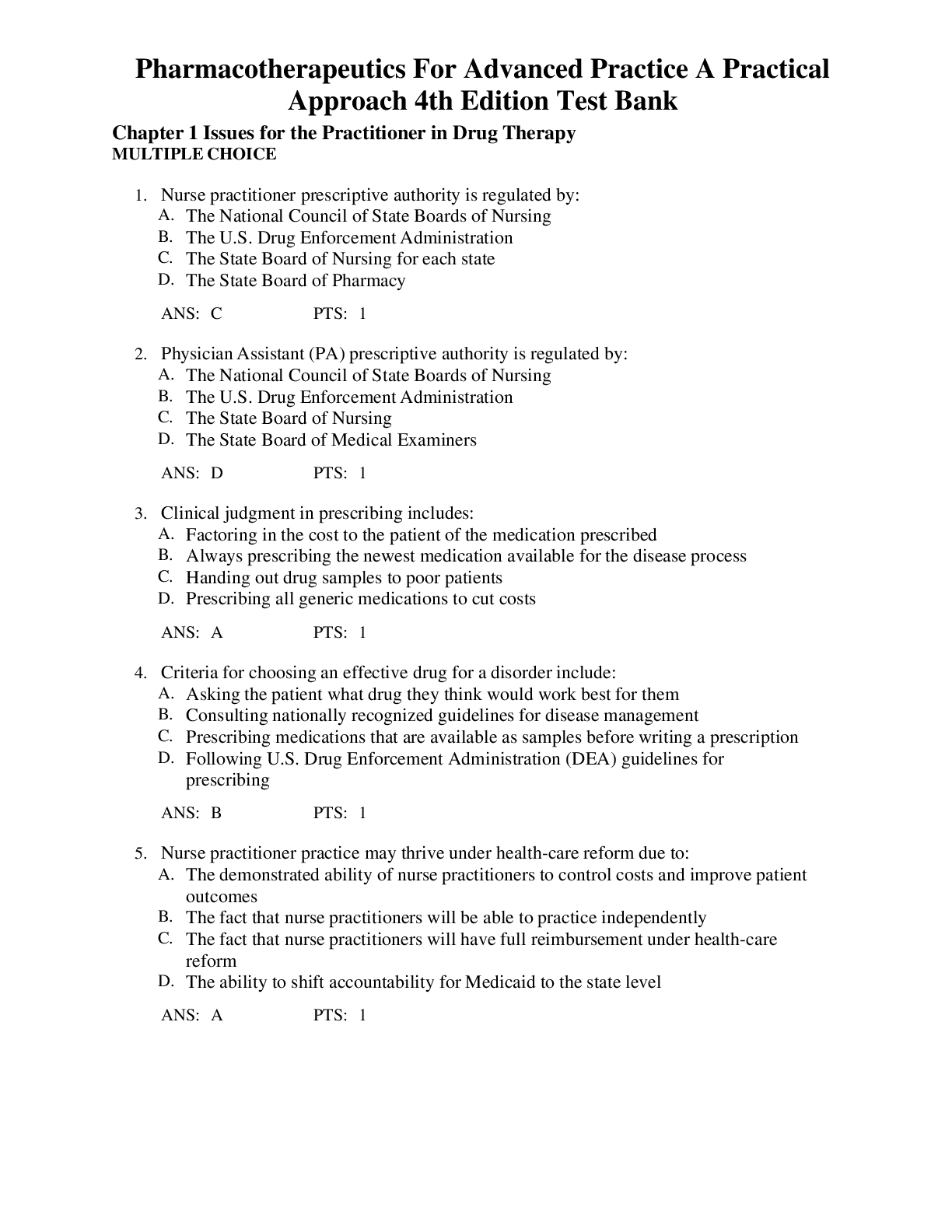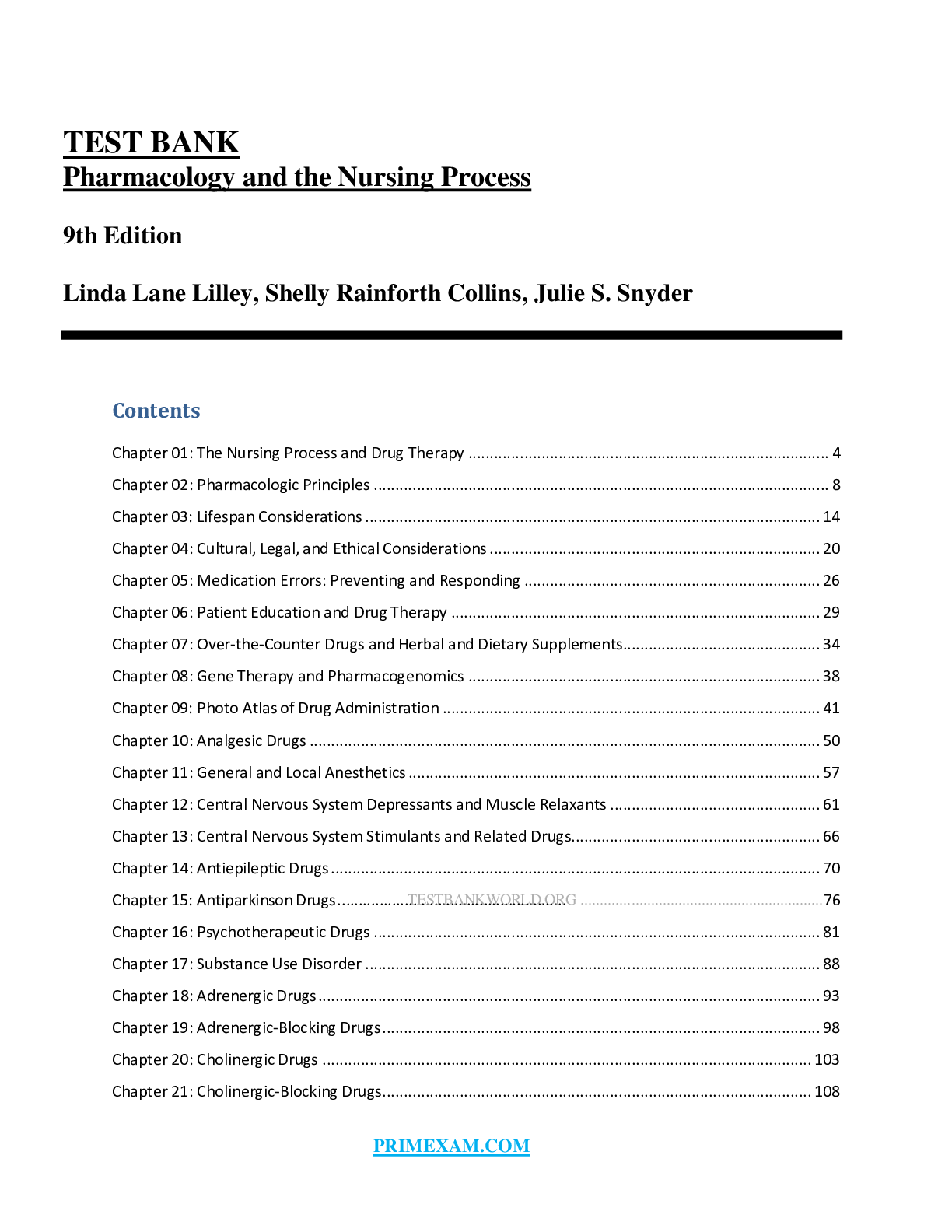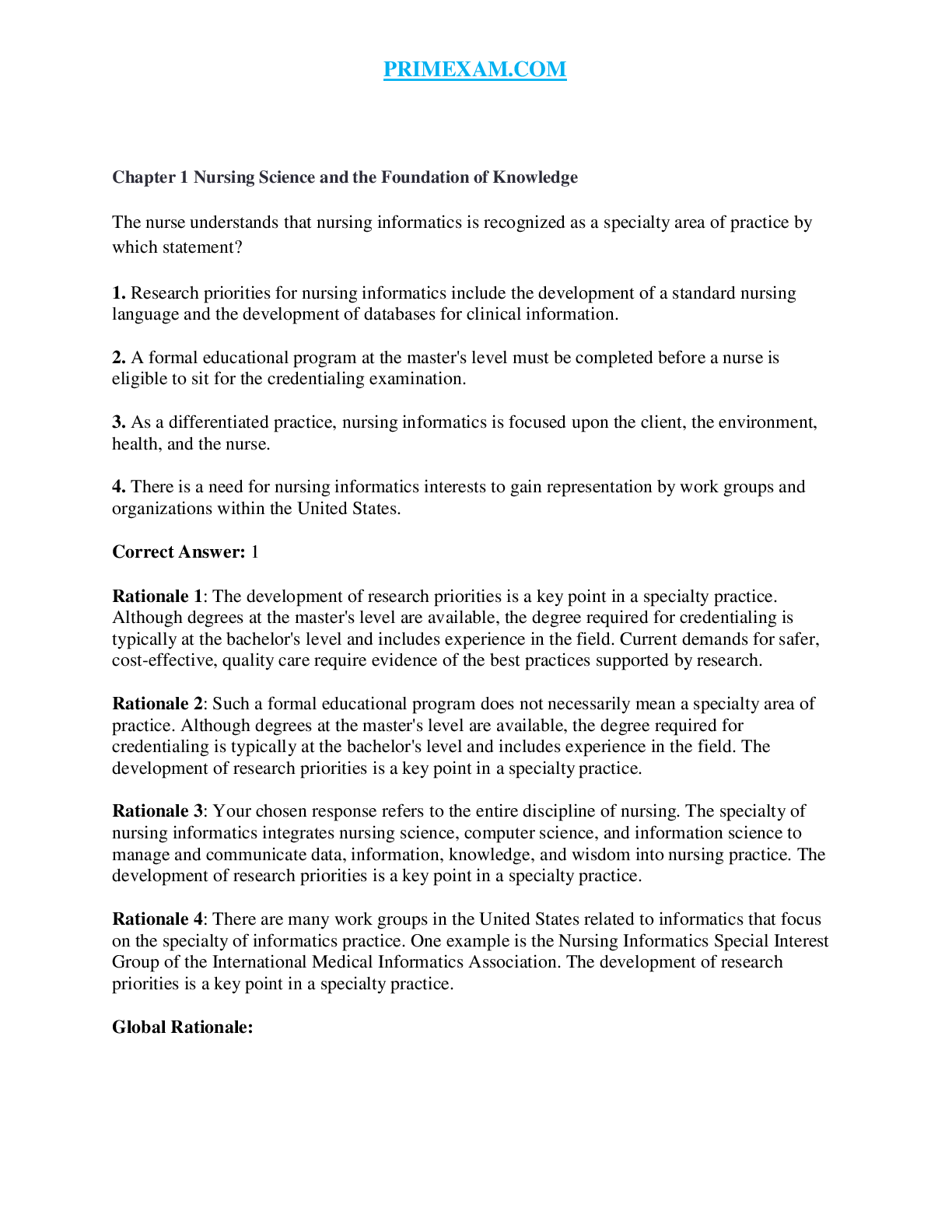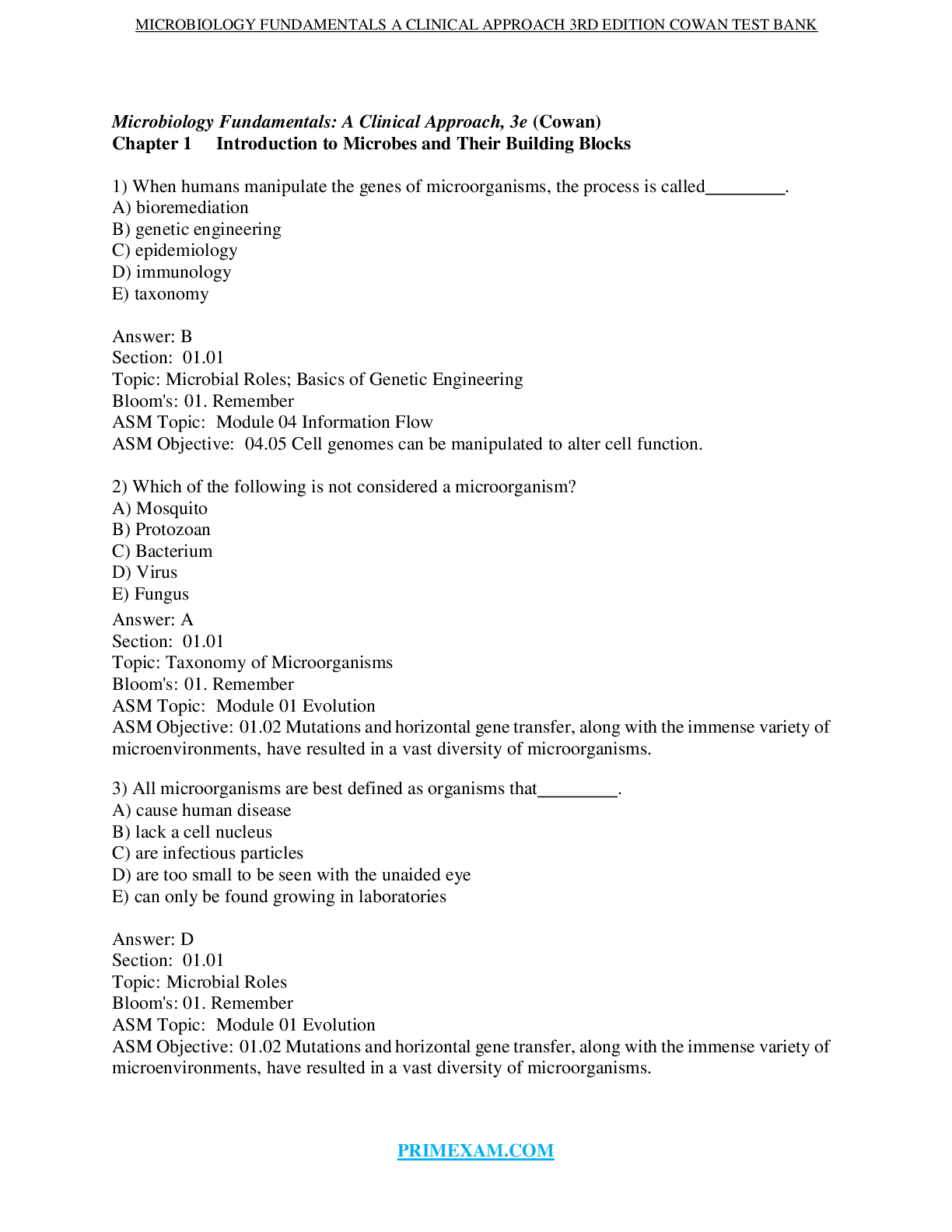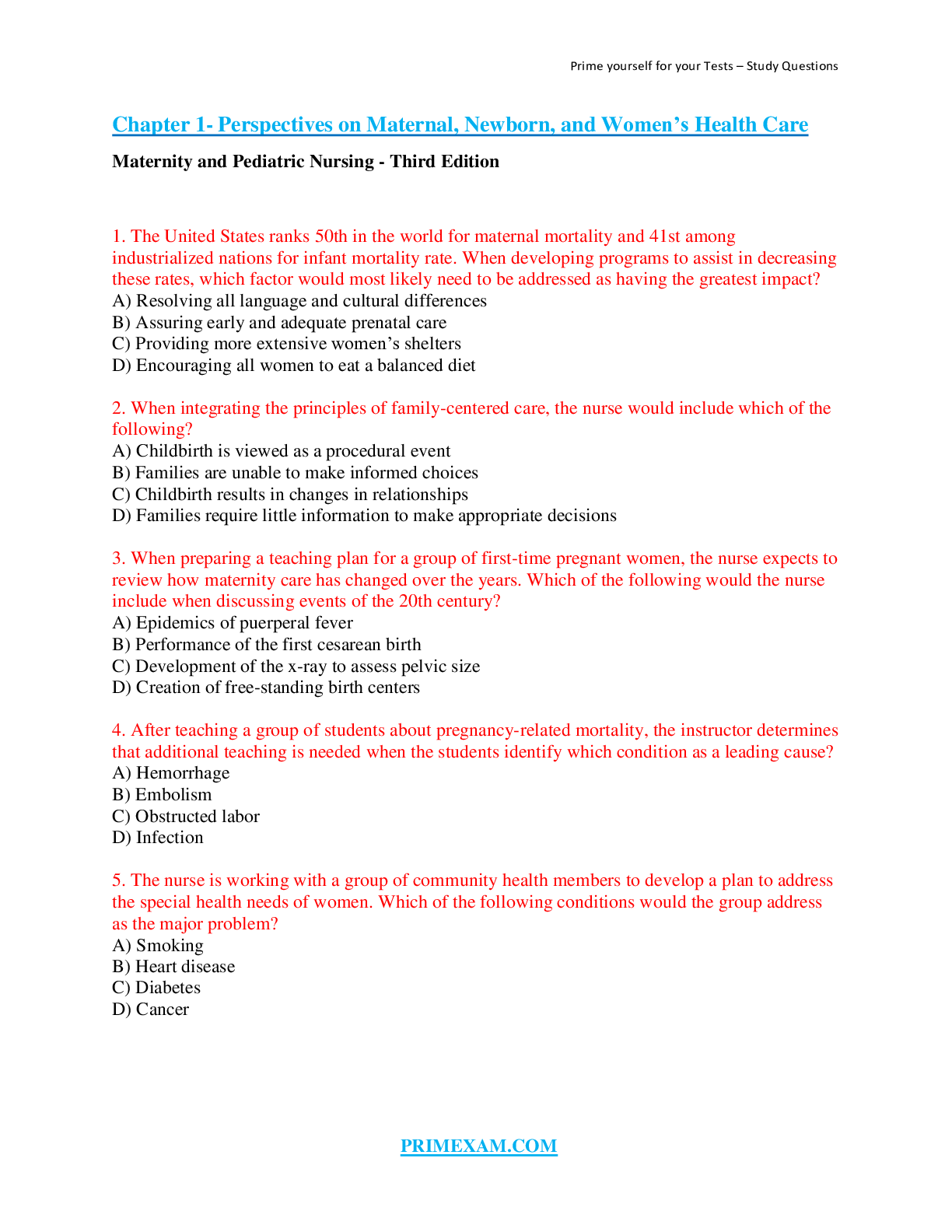Harding: Lewis’s Medical-Surgical Nursing, 11th Edition Test Bank
Document Content and Description Below
MULTIPLE CHOICE /test abirb.com 1. The nurse completes an admission database and explains that the plan of care and discharge goals will be developed with the patient’s input. The patient a... sks, “How is this different from what the doctor does?” Which response would be most appropriate for the nurse to make? a. “The role of the nurse is to administer medications and other treatments prescribed by your doctor.” b. “In addition to caring for you while you are sick, the nurses will help you plan to maintain your health.” c. “The nurse’s job is to help the doctor by collecting information and communicating any problems that occur.” d. “Nurses perform many of the same procedures as the doctor, but nurses are with the patients for a longer time than the doctor.” ANS: B abirb.com/test The American Nurses Association (ANA) definition of nursing describes the role of nurses in promoting health. The other responses describe dependent and collaborative functions of the nursing role but do not accurately describe the nurse’s unique role in the health care system. DIF: Cognitive Level: Analyzae (baniarlybsis.)com/test TOP: Nursing Process: Implementation MSC: NCLEX: Safe and Effective Care Environment 2. The nurse describes to a studeantbniurrsbe .hcowotmo u/seteevsidtence-based practice (EBP) when caring for patients. Which statement by the nurse accurately describes the use of EBP? a. “Inferences from all published articles are used as a guide.” b. “Patient care is based on clinical judgment, experience, and traditions.” c. “Data are analyzed later to show that the patient outcomes are consistently met.” d. “Recommendations are based on research, clinical expertise, and patient preferences.” ANS: D abirb.com/test Evidence-based practice (EBP) is the use of the best research-based evidence combined with clinician expertise and consideration of patient preferences. Clinical judgment based on the nurse’s clinical experience isapabrt iorfbEB.cP,obumt c/litneicasl tdecision making should also incorporate current research and research-based guidelines. Evaluation of patient outcomes is important, but data analysis is not required to use EBP. All published articles do not provide research evidence; interventions should be based on credible research, preferably randomized controlled studies with a large number of subjects. DIF: Cognitive Level: Remember (knowledge) TOP: Nursing Process: Planning MSC: NCLEX: Safe and EffectiavebCiarrebE.ncviroonmme/ntt est 3. The nurse teaches a student nurse about how to apply the nursing process when providing patient care. Which statement by the student nurse indicates that teaching was successful? a. “The nursing process is a research method of diagnosing the patient’s health care problems.” b. “The nursing process is used primarily to explain nursing interventions to other abirb.com/test health care professionals.” c. “The nursing process is a problem-solving tool used to identify and treat the patients’ health care needs.” d. “The nursing process is based on nursing theory that incorporates the biopsychosocial nature ofahubmiarnbs..”com/test ANS: C The nursing process is a problem-solving approach to the identification and treatment of patients’ problems. Nursing parobceisrsbdo.ecs onomt re/qtueiresrtesearch methods for diagnosis. The primary use of the nursing process is in patient care, not to establish nursing theory or explain nursing interventions to other health care professionals. DIF: Cognitive Level: Undersatanbd (icrobm.pcrehoenmsion/)test MSC: NCLEX: Safe and Effective Care Environment TOP: Nursing Process: Evaluation 4. A patient admitted to the hospital for surgery tells the nurse, “I do not feel comfortable leaving my children with my parents.” Which action should the nurse take next? a. Reassure the patient that these feelings are common for parents. b. Have the patient call the children to ensure that they are doing well. c. Gather information on theapbatiiernbt’s.ccooncmern/staebosuttthe child care arrangements. d. Call the patient’s parents to determine whether adequate child care is being provided. ANS: C abirb.com/test Because a complete assessment is necessary in order to identify a problem and choose an appropriate intervention, the nurse’s first action should be to obtain more information. The other actions may be appropraiatbe, ibrubt m.coroe amsse/stsemesnttis needed before the best intervention DIF: Cognitive Level: Analyze (analysis) OBJ: Special Questions: Prioriatizbatiiornb.cToOPm: N/utresinsg tProcess: Assessment MSC: NCLEX: Psychosocial Integrity 5. A patient with a bacterial infection is hypovolemic due to a fever and excessive diaphoresis. Which expected outcome would the nurse recognize as appropriate for this patient? a. Patient has a balanced intake and output. b. Patient’s bedding is kept clean and free of moisture. c. Patient understands the need for increased fluid intake. d. Patient’s skin remains cool and dry throughout hospitalization. ANS: A Balanced intake and output gives measurable data showing resolution of the problem of deficient fluid volume. The other statements would not indicate that the problem of hypovolemia was resolved. DIF: Cognitive Level: Apply (aapbpliicrabtio.nc) om/TtOeP:st MSC: NCLEX: Physiological Integrity Nursing Process: Planning 6. After administering medication, the nurse asks the patient if pain was relieved. What is the purpose of the evaluation phase of the nursing process? a. To document the nursing care plan in the progress notes of the health record b. To determine if interventions have been effective in meeting patient outcomes abirb.com/test c. To decide whether the patient’s health problems have been completely resolved d. To establish if the patient agrees that the nursing care provided was satisfactory ANS: B Evaluation consists of determining whether the desired patient outcomes have been met and whether the nursing interventions were appropriate. The other responses do not describe the evaluation phase. DIF: Cognitive Level: Understand (comprehension) MSC: NCLEX: Safe and Effective Care Environment TOP: Nursing Process: Evaluation 7. The nurse interviews a patient while completing the health history and physical examination. What is the purpose of the assaesbsmirebnt .pchaosemof /thteensurtsing process? a. To teach interventions that relieve health problems b. To use patient data to evaluate patient care outcomes c. To help the patient identify realistic outcomes for health problems d. To obtain data with which to diagnose patient strengths and problems ANS: D During the assessment phase, the nurse gathers information about the patient to diagnose patient strengths and problems. The other responses are examples of the planning, intervention, and evaluation phases of the nursing process. DIF: Cognitive Level: Undersatanbd i(crobm.pcrehoenmsion/)test TOP: Nursing Process: Assessment MSC: NCLEX: Safe and Effective Care Environment 8. The nurse admits a patient to the hospital and develops a plan of care. What components should the nurse include in the patient problem statement? a. The problem and the suggested patient goals or outcomes b. The problem, its causes, and the signs and symptoms of the problem c. The problem with the posasibbleiretbio.locgoy amnd /thtee pslatnned interventions The problem, the pathophysiology of the problem, and the expected outcome ANS: B When writing patient problemas borinrubrs.incgodimagn/otseess, tthis format should be used: problem, etiology, and signs and symptoms. The subjective as well as objective data should be included. Goals, outcomes, and interventions are not included in the problem statement. DIF: Cognitive Level: Undersatanbd (icrobm.pcrehoenmsion/)test MSC: NCLEX: Safe and Effective Care Environment TOP: Nursing Process: Diagnosis 9. Which patient care task is appropriate for the nurse to delegate to experienced unlicensed assistive personnel (UAP)? a. Instruct the patient about the need to alternate activity and rest. b. Monitor level of shortness of breath or fatigue after ambulation. c. Obtain the patient’s bloodapbresisrubre.acnod pmuls/etreatse atfter ambulation. d. Determine whether the patient is ready to increase the activity level. ANS: C UAP education includes accuarabte ivritbal.scigon mmea/stueresmetnt. Assessment and patient teaching require registered nurse education and scope of practice and cannot be delegated. abirb.com/test DIF: Cognitive Level: Apply (application) OBJ: Special Questions: Delegation TOP: Nursing Process: Planning MSC: NCLEX: Safe and Effective Care Environment 10. A nurse is caring for a group of patients on the medical-surgical unit with the help of one float registered nurse (RN), one unlicensed assistive personnel (UAP), and one licensed practical/vocational nurse (LPN/VN). Which assignment, if delegated by the nurse, would be inappropriate? a. Check for the presence ofabobwierlbso.ucndos mby /UtAePst b. Administration of oral medications by LPN/VN c. Insulin administration by float RN from the pediatric unit d. Measurement of a patienta’s buriinrabry.ccaothemter/otuetpsuttby UAP ANS: A Assessment requires RN education and scope of practice so it cannot be delegated to an LPN/VN or UAP. The other aassbiginrmben.tcs omamde /btyethsetRN are appropriate for the role of the DIF: Cognitive Level: Apply (application) OBJ: Special Questions: Delegation TOP: Nursing Process: Planning MSC: NCLEX: Safe and Effective Care Environment 11. Which task is appropriate for the nurse to delegate to a licensed practical/vocational nurse (LPN/VN)? abirb.com/test a. Complete the initial admission assessment and plan of care. b. Measure bedside blood glucose before administering insulin. c. Document teaching completed before a diagnostic procedure. d. Instruct a patient about low-fat, reduced sodium dietary restrictions. ANS: B The education and scope of practice of the LPN/LVN include activities such as obtaining glucose testing using a finger stick and administering insulin. Patient teaching and the initial assessment and development of the plan of care are nursing actions that require registered nurse education and scope ofaprbacitricbe..com/test DIF: Cognitive Level: Apply (application) OBJ: Special Questions: Delegation TOP: Nursing Process: Planning MSC: NCLEX: Safe and EffectiavebCiarrebE.ncviroonmme/ntt est 12. A nurse is assigned as a case manager for a hospitalized patient with a spinal cord injury. Which activity can the patient expect the nurse in this role to perform? a. Care for the patient duringahbosipribtal.iczaotiomn fo/rtethesintjuries. b. Assist the patient with home care activities during recovery. c. Coordinate the services the patient receives in the hospital and at home. d. Determine what medical caarbe ithrebp.actieontmnee/dtsefosrtoptimal rehabilitation. ANS: C The role of the case manager is to coordinate the patient’s care through multiple settings and levels of care to allow the maximal patient benefit at the least cost. The case manager does not provide direct care in the acute or home setting. The case manager coordinates and advocates for care the HCP determines what medical care is needed. abirb.com/test DIF: Cognitive Level: Apply (application) TOP: Nursing Process: Implemaenbtatiirobn .cMoSmC: N/CteLEsXt: Safe and Effective Care Environment 13. The nurse is caring for an older adult patient who needs continued nursing care and physical therapy to improve mobility after surgery to repair a fractured hip. The nurse would help to arrange for transfer of the patient to which facility? a. A skilled care facility b. A transitional care facility c. A residential care facilityabirb.com/test d. An intermediate care facility ANS: B Transitional care settings are aapbpriorpbria.tce foormpat/iteentsswtho need continued rehabilitation before discharge to home or to long-term care settings. The patient is no longer in need of the more continuous assessment and care given in acute care settings. There is no indication that the patient will need the permanent and ongoing medical and nursing services available in intermediate or skilled care. The patient is not yet independent enough to transfer to a residential care facility. DIF: Cognitive Level: Apply (aapbpliicrabtio.nc) om/TtOeP:st MSC: NCLEX: Safe and Effective Care Environment Nursing Process: Planning 14. A home care nurse is planning care for a patient who has just been diagnosed with type 2 diabetes. Which task is appropriate for the nurse to delegate to the home health aide? a. Assist the patient to choose appropriate foods. b. Help the patient with a daily bath and oral care. c. Check the patient’s feet foar bsiginrsbo.fcbroeamkdo/wten. st d. Teach the patient how to ANS: B Assisting with patient hygienae ibs iinrcblud.ecdoinmho/mteehseatlth-aide education and scope of practice. Assessment of the patient and instructing the patient in new skills, such as diet and blood glucose monitoring, are complex skills that are included in registered nurse education and scope of practice. abirb.com/test DIF: Cognitive Level: Apply (application) OBJ: Special Questions: Delegation TOP: Nursing Process: Implementation MSC: NCLEX: Safe and EffectiavebCiarrebE.ncviroonmme/ntt est 15. The nurse is providing education to nursing staff on quality care initiatives. Which statement is an accurate description of the impact of health care financing on quality care? a. “If a patient develops a caathbeteirr-brel.acteod imnfe/cttieons, tthe hospital receives additional funding.” b. “Payment for patient care is primarily based on clinical outcomes and patient satisfaction.” abirb.com/test c. “Hospitals are reimbursed for all costs incurred if care is documented electronically.” d. “Because hospitals are accountable for overall care, it is not nursing’s responsibility to monitor acarbe idrebliv.ecreod bmy o/ttheerss.”t ANS: B abirb.com/test Payment for health care services programs reimburses hospitals for their performance on overall quality-of-care measures. These measures include clinical outcomes and patient satisfaction. Nurses are responsible for coordinating complex aspects of patient care, including the care delivered by others, and identifying issues that are associated with poor quality care. Payment for careacbanirbebw.cithohemld i/ftseomsetthing happens to the patient that is considered preventable (e.g., acquiring a catheter-related urinary tract infection). DIF: Cognitive Level: Apply (application) TOP: Nursing Process: Implemaenbtatiirobn .cMoSmC: N/CteLEsXt: Safe and Effective Care Environment 16. The nurse documenting the patient’s progress in the electronic health record before an interprofessional discharge coanfberiernbce.ics doemmon/stteratsintg competency in which QSEN a. Patient-centered care b. Evidence-based practice c. Quality improvement abirb.com/test d. Informatics and technology ANS: D The nurse is displaying compaetebncirybin.tcheoQmSE/Ntearesatof informatics and technology. Using a computerized information system to document patient needs and progress and communicate vital information about the patient with the interprofessional care team members provides evidence that nursing practice standards related to the nursing process have been maintained during the care of the patient. DIF: Cognitive Level: Apply (application) TOP: Nursing Process: Implemaenbtatiirobn .cMoSmC: N/CteLEsXt: Safe and Effective Care Environment MULTIPLE RESPONSE abirb.com/test 1. Which information will the nurse consider when deciding what nursing actions to delegate to a licensed practical/vocational nurse (LPN/VN) who is working on a medical-surgical unit? (Select all that apply.) a. Institutional policies b. Stability of the patients c. State nurse practice act abirb.com/test d. LPN/VN teaching abilities e. Experience of the LPN/VN ANS: A, B, C, E The nurse should assess the eaxpberiiernbce.cofoLmPN//VtNesswthen delegating. In addition, state nurse practice acts and institutional policies must be considered. In general, while the LPN/VN scope of practice includes caring for patients who are stable, registered nurses should provide most of the care for unstable patients. Because the LPN/VN scope of practice does not include patient education, this will not be part of the delegation process. DIF: Cognitive Level: Apply (application) OBJ: Special Questions: Delegation TOP: Nursing Process: Planning MSC: NCLEX: Safe and Effective Care Environment abirb.com/test 2. Which actions by the nurse administering medications are consistent with promoting safe delivery of patient care? (Select all that apply) a. Discards a medication that unlabeled. b. Uses a hand sanitizer before preparing a medication. c. Identifies the patient by thae broiormbn.ucmobemr on/ttehesdotor. Checks laboratory test results before administering a diuretic. e. Gives the patient a list of current medications upon discharge. ANS: A, B, D, E abirb.com/test National Patient Safety Goals have been established to promote safe delivery of care. The nurse should use at least 2 reliable ways to identify [Show More]
Last updated: 1 year ago
Preview 1 out of 86 pages

Reviews( 0 )
Document information
Connected school, study & course
About the document
Uploaded On
Nov 03, 2021
Number of pages
86
Written in
Additional information
This document has been written for:
Uploaded
Nov 03, 2021
Downloads
0
Views
55


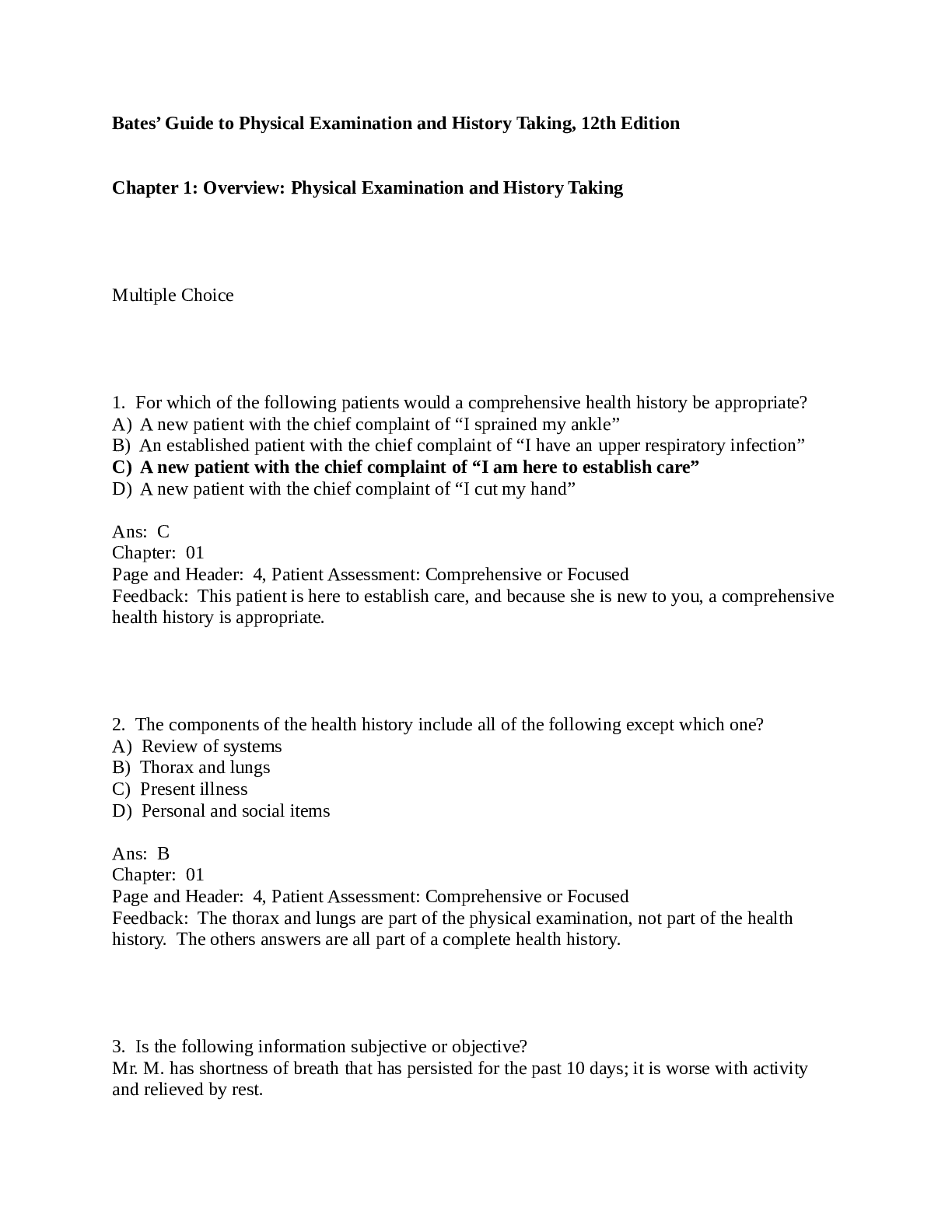
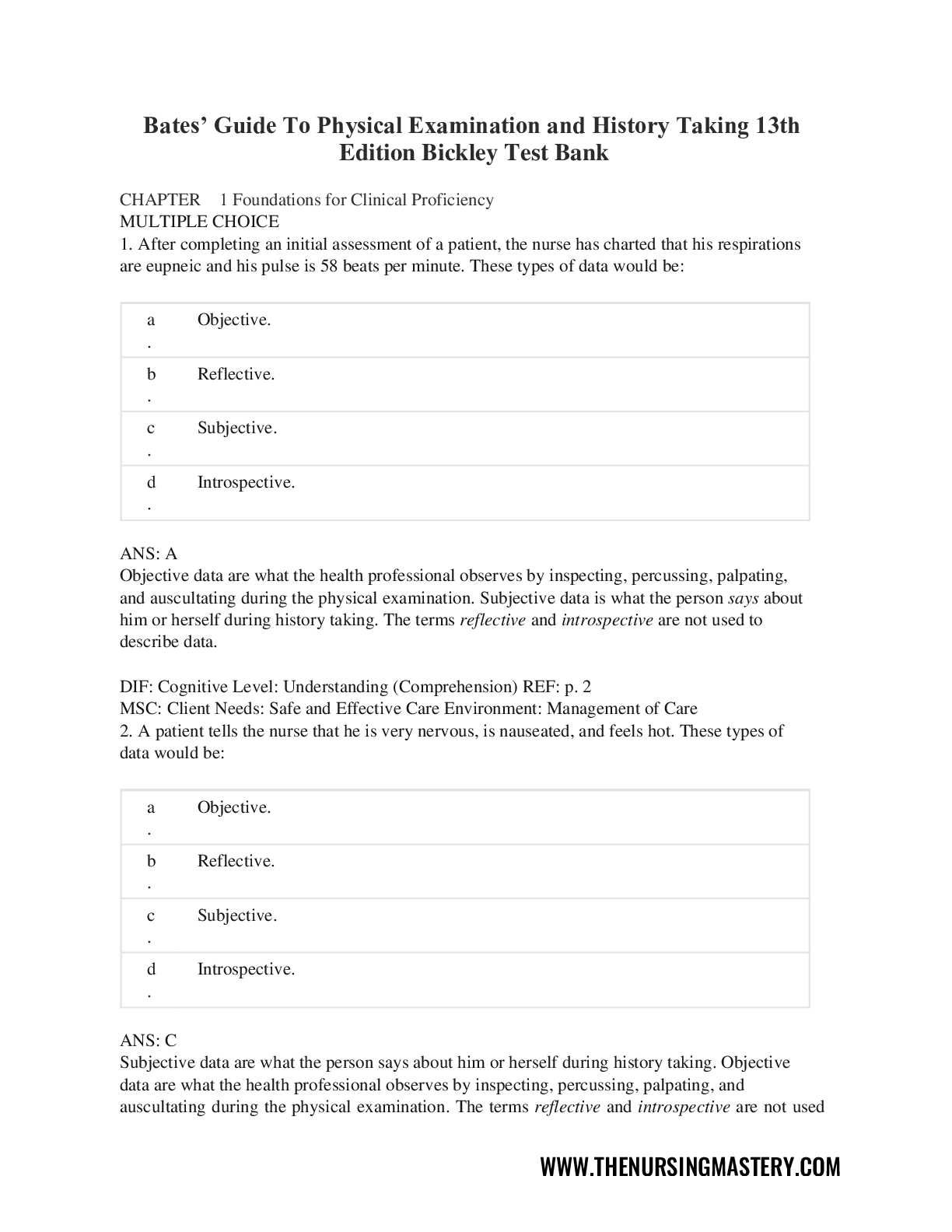
.png)
.png)
.png)

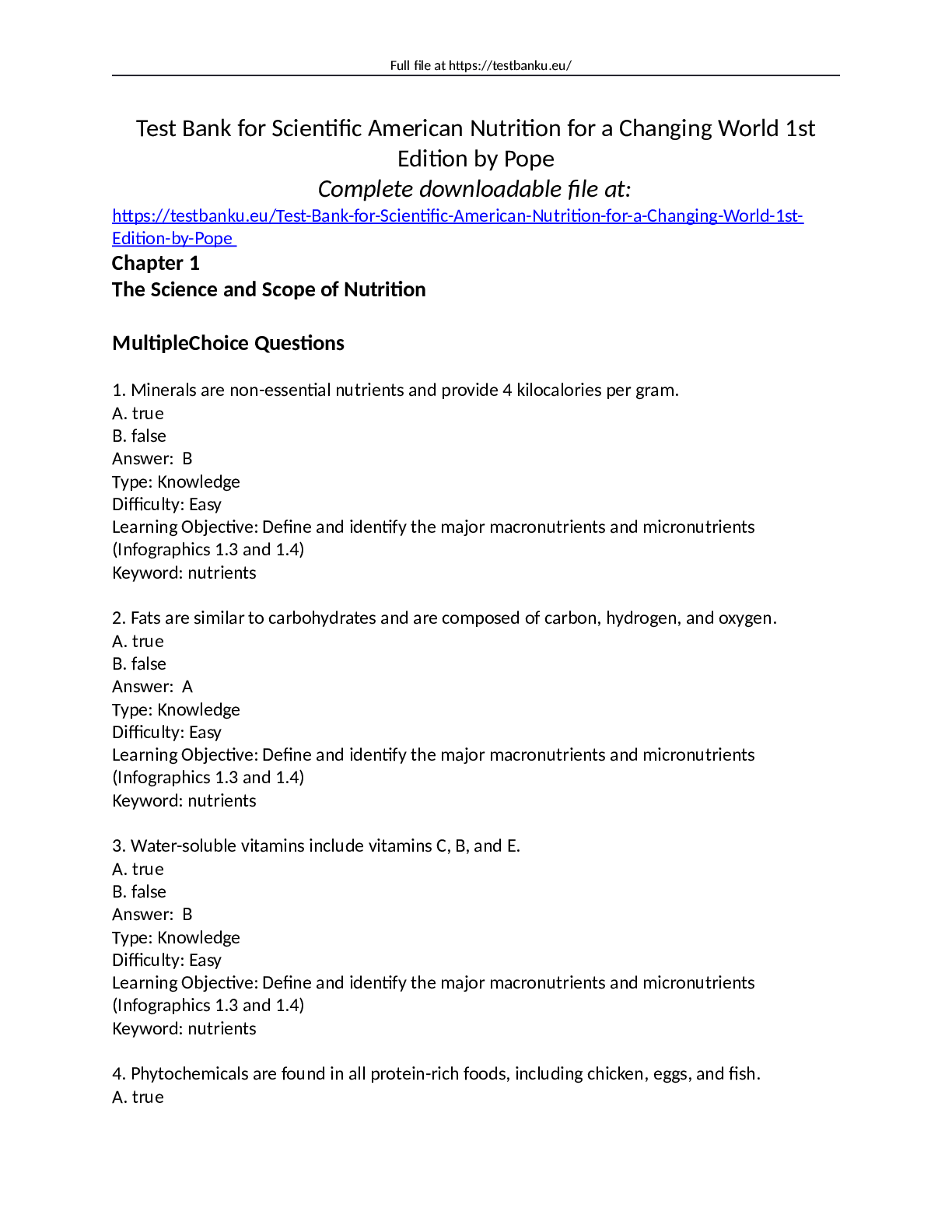
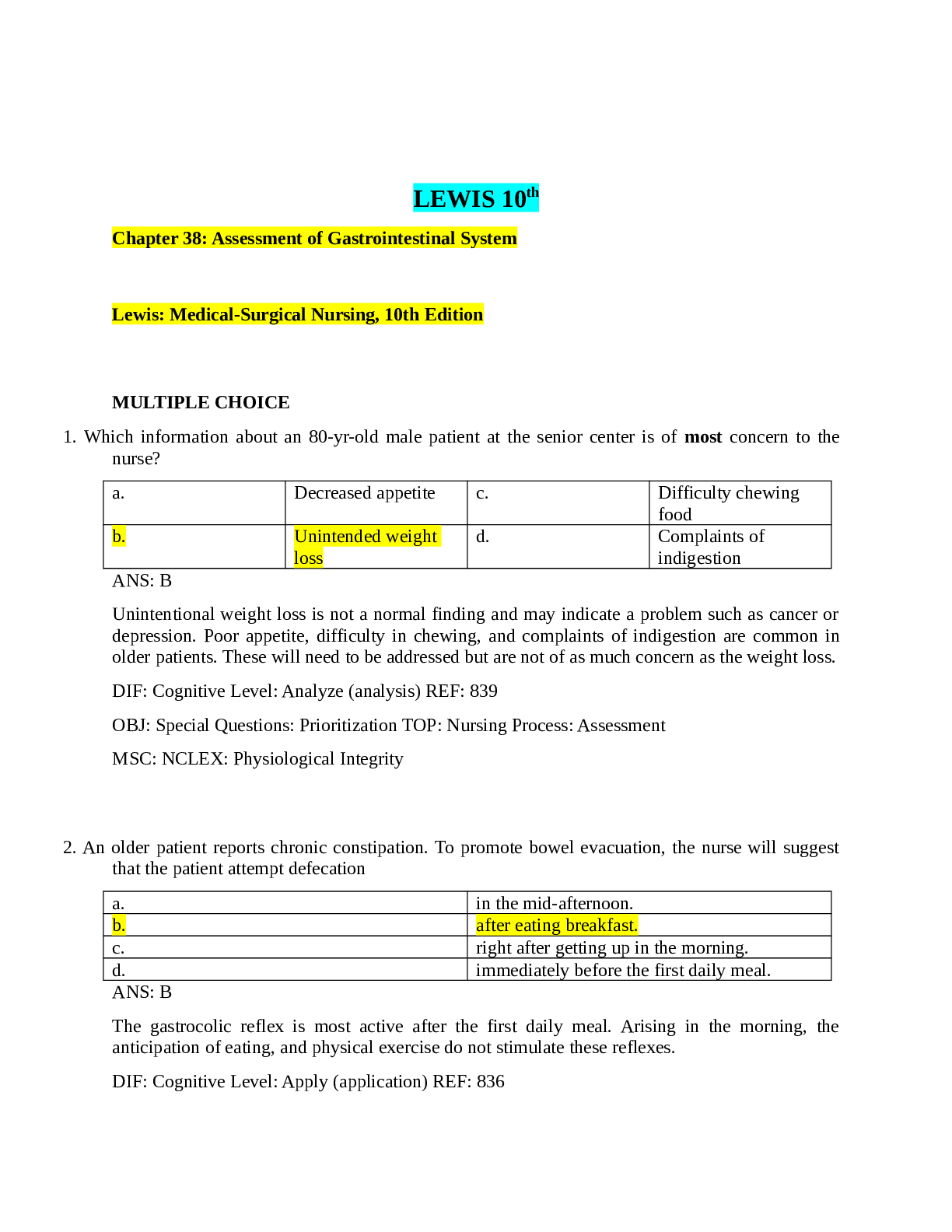

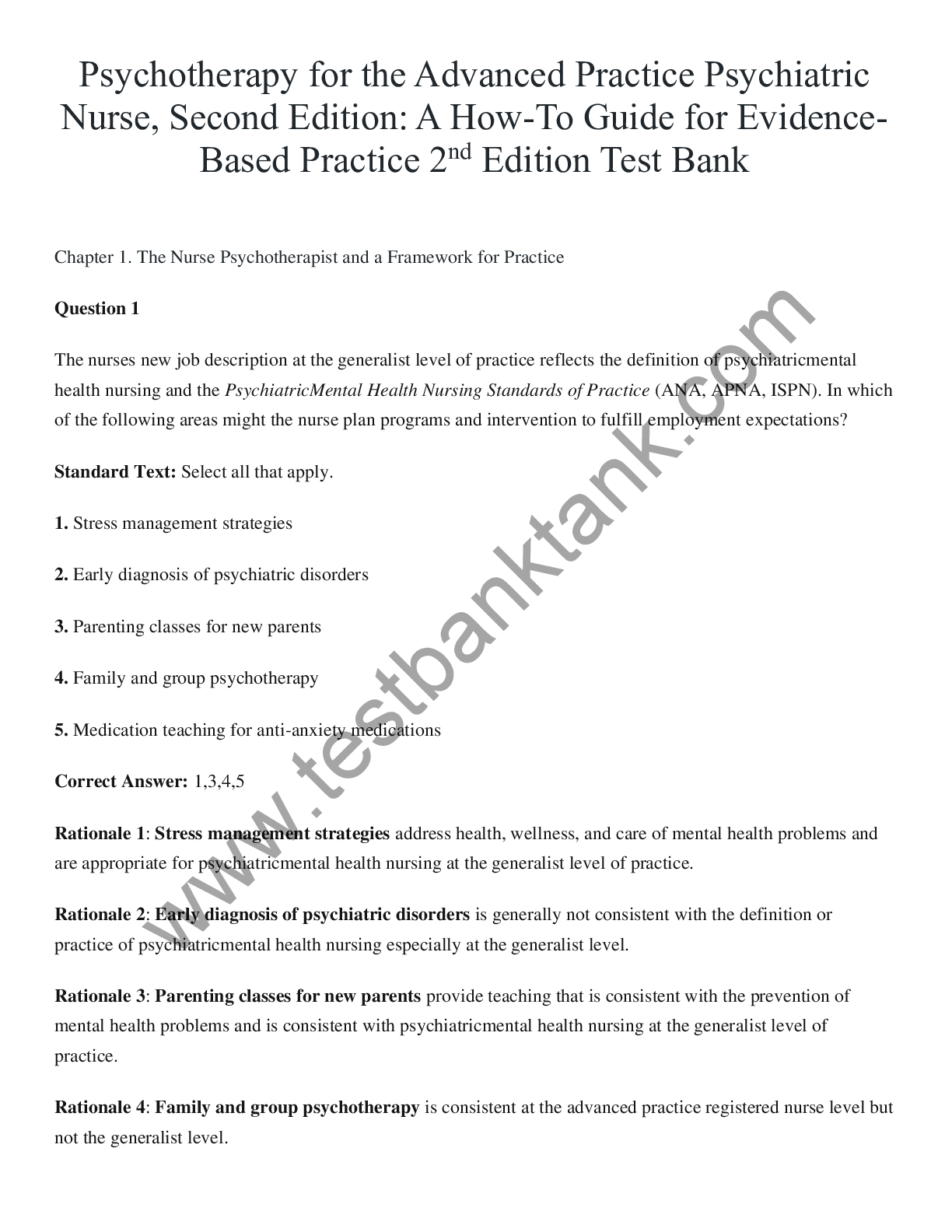
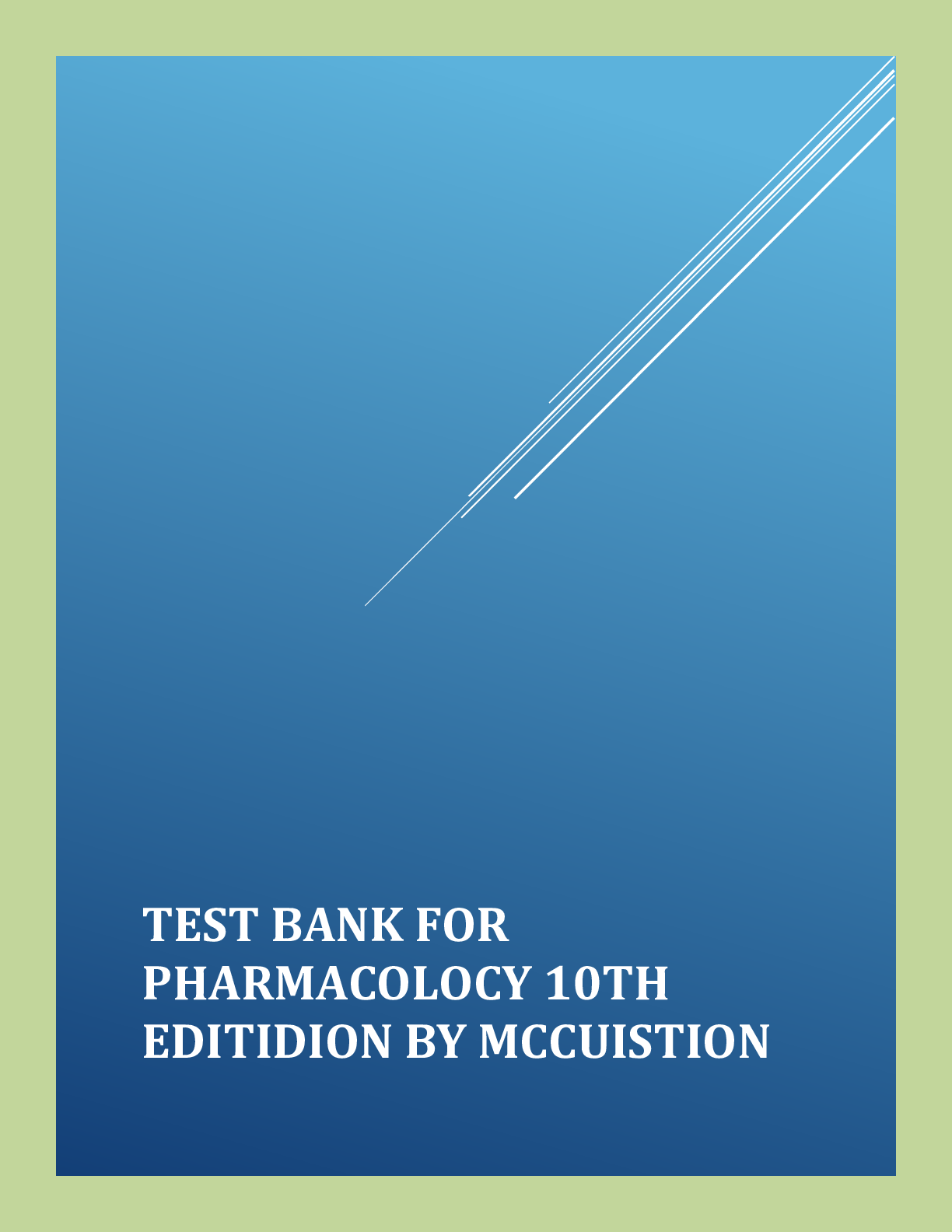
.png)





